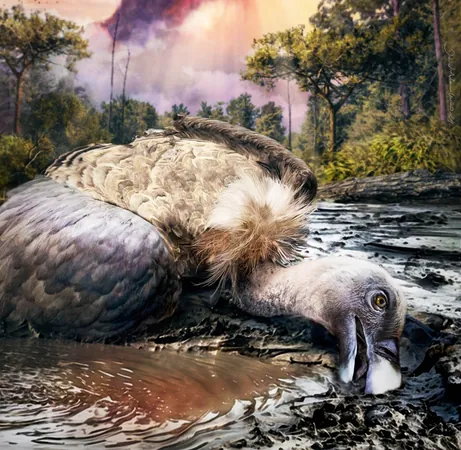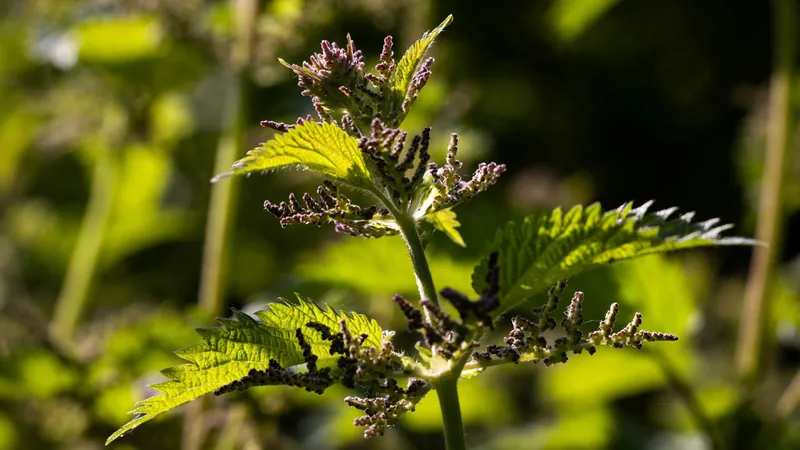
Revolutionary Vulture Fossil Discovery: Volcanic Rock Unveils Secrets of Feather Preservation!
2025-03-24
Author: Siti
Revolutionary Vulture Fossil Discovery: Volcanic Rock Unveils Secrets of Feather Preservation!
In the captivating saga of Earth's history, every fossil serves as a window into the ancient past, revealing intricate narratives of evolution, extinction, and vast environmental changes. A groundbreaking find involving a 30,000-year-old vulture fossil from Central Italy has recently emerged, providing compelling evidence that volcanic rock can astonishingly preserve feathers in remarkable detail—a phenomenon previously undocumented in scientific literature.
A Remarkable Find: The 30,000-Year-Old Vulture Fossil
This extraordinary fossil, initially unearthed near Rome in 1889 by a local landowner, was celebrated for its exceptional state of preservation even back then. Unlike typical fossils that often lose their three-dimensional structures under immense geological pressure, this vulture specimen remarkably retained its original form, showcasing intricate features like eyelids and delicate wing feathers.
For over a century, the fossil has intrigued paleontologists, but with today’s advanced microscopic and chemical analysis techniques, researchers have finally been able to unlock its full potential. These sophisticated tools have paved the way for unprecedented examinations revealing vital information about fossilization processes and volcanic environments.
Uncharted Territory: Microscopic Feather Preservation
Led by Dr. Valentina Rossi from University College Cork, the research team delved deeply into the vulture fossil. In their recent publication in Geology, they highlight an extraordinary discovery: feather intricacies preserved down to the microscopic level, which is groundbreaking in the realm of paleontology.
Dr. Rossi emphasizes the unusual preservation circumstances, stating, "Fossil feathers are typically found in ancient mudrock environments, not volcanic ash. Analyzing this fossil pushed us into exciting new territory, presenting feathers that defy typical fossilization expectations."
Zeolite: The Unsung Hero of Fossil Preservation
Using cutting-edge electron microscopes and chemical analysis, researchers discovered an unexpected preservation mechanism involving zeolite, a mineral common in volcanic and hydrothermal settings. The chemical interaction of water flowing through ash layers led to the formation of zeolite nanocrystals, which brilliantly replicated the microscopic details of the vulture’s feathers.
This revelation indicates that under specific conditions, volcanic environments can facilitate incredible fossil preservation, challenging long-held perspectives about the destructive nature of volcanic activity.
Rethinking Fossil Preservation in Volcanic Environments
Traditionally deemed hostile for the preservation of organic material, volcanic landscapes have primarily been associated with extreme heat and destructive pyroclastic flows. Yet this study sheds light on how low-temperature volcanic deposits can envelop and safeguard delicate tissues, suggesting a more complex relationship between fossilization and volcanic activity than previously understood.
Professor Dawid A. Iurino from the University of Milan articulates this paradigm shift: “We often associate volcanic activity with destruction, but this research reveals that some volcanic deposits may actually create a protective environment for soft tissues."
Opening New Vistas for Paleontological Research
The implications of this breakthrough cannot be overstated. The fossil record may be far richer than previously imagined, as many researchers have concentrated their fossil hunts solely within sedimentary rock formations. The insights from this study encourage scientists to delve into volcanic deposits, which could harbor a treasure trove of well-preserved fossils, including soft tissues previously thought lost to time.
As Professor Maria McNamara from University College Cork insightfully notes, “This discovery broadens the horizons for potential fossil exploration, compelling us to rethink where and how we search for ancient specimens.”
Conclusion: A New Era in Paleontology
With this remarkable vulture fossil illuminating untapped avenues of fossil preservation, the landscape of paleontological research is on the verge of profound transformation. Future studies may unveil further instances of soft tissue conservation within volcanic deposits, potentially revolutionizing our understanding of ancient life and fossilization pathways.
As researchers continue to explore the complexities of these environments, we stand on the cusp of discovering even more hidden secrets from our planet’s past—possibilities that could reshape our understanding of life's history on Earth.
Stay updated on this and other riveting developments in paleontology by subscribing to our newsletter and joining the conversation about uncovering the mysteries of our planet's ancient inhabitants!


 Brasil (PT)
Brasil (PT)
 Canada (EN)
Canada (EN)
 Chile (ES)
Chile (ES)
 Česko (CS)
Česko (CS)
 대한민국 (KO)
대한민국 (KO)
 España (ES)
España (ES)
 France (FR)
France (FR)
 Hong Kong (EN)
Hong Kong (EN)
 Italia (IT)
Italia (IT)
 日本 (JA)
日本 (JA)
 Magyarország (HU)
Magyarország (HU)
 Norge (NO)
Norge (NO)
 Polska (PL)
Polska (PL)
 Schweiz (DE)
Schweiz (DE)
 Singapore (EN)
Singapore (EN)
 Sverige (SV)
Sverige (SV)
 Suomi (FI)
Suomi (FI)
 Türkiye (TR)
Türkiye (TR)
 الإمارات العربية المتحدة (AR)
الإمارات العربية المتحدة (AR)